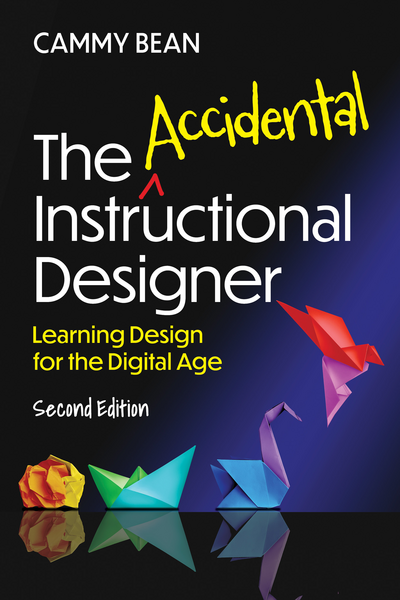ATD Blog
Building a Robust Career Through Instructional Design
Mon Apr 24 2023


Many trainers and instructional designers fall into the talent development profession by accident, often having been tasked by their organization to train others on a subject they are expert in. Whether they’re good at explaining technical concepts or have a way with PowerPoint, they have often have little to no formal education in instructional design. Many are looking for grounding in the core principles of instructional design so that they can design effective and engaging digital learning experiences.
The Accidental Instructional Designer explores nearly every aspect of the learning design process for those getting started or even for the experienced practitioner in need of new ideas. In this Q&A, the author, e-learning veteran Cammy Bean shares what readers can expect from this updated edition.
First things first, just what is instructional design and why all the accidents?
For years, I’d tell people I worked as an instructional designer (ID), and I’d mostly get blank stares. Unless you’re already working in training and development, you’ve probably never heard of it. In simple terms, instructional design is the art and science that goes into the making of instruction. In the modern, corporate world, instructional designers are the people who design and develop training programs—be they live, in-person classroom events, self-paced online or “e-learning” experiences, training videos, job aids, and performance support, or something else in the spirit of instruction.
There are precise definitions of instructional design and then there’s the reality of instructional design as it’s become somewhat of an umbrella term for a lot of specific tasks and activity that go into the design and development of training. Some instructional designers create graphics and animation and build courses in e-learning authoring tools; others manage their company’s Learning Management System; some IDs do detailed training needs analysis; and so on.
I call it “accidental instructional design” because many of the people who do instructional design work fall into it by accident. Perhaps they demonstrate some capability or skill that gets tapped by a training team to help them train employees: “Hey, she’s really good with PowerPoint. She can help us create training decks!” Or they might be a subject matter expert and get asked to train others on that subject area: “You know how to do this job really well. You are the best-qualified person to teach others.” The path to instructional design is different for everyone but the result is we end up with a lot of people practicing as IDs who need to figure out what they’re doing and how to do it in the most effective way possible to have an impact on the people who need training.
Is this book just for instructional designers?
This book is a great resource for anyone who finds themselves involved with the design and development of training materials, and for those who have a stake in the outcomes produced by the training and education team. Whether your job title is instructional designer, course developer, training manager, product marketer, LMS administrator, chief learning officer, or something else, chances are there’s something in here that will be useful to you. You’ll get grounding in some core concepts and approaches to instructional design, see how and where ID fits into an organization, and get some ideas and inspirations that can be applied to specific learning projects.
If one becomes an instructional designer, what’s next? Are they doing instructional design for the rest of their careers or are there other opportunities?
One of the things I love the most about this industry is that there are so many places to take yourself. In the book, I talk about four pieces of the Learning Pie that those of us who work in this field need to become versant in: learning science, creativity, technology, and business. Each of those pieces of pie then gets further sliced up into specific skills—e.g., storytelling or graphic design.
If you’re working as an entry-level ID, you may be focused on one or two small pieces of that pie. As your expertise grows, it’s important to get a broad understanding of all areas of the pie—that’s the big system that training lives in. From there, a practitioner can go deeper and evolve. Let’s say you’re really into instructional design and data science. You can focus down that path and probably find some amazing opportunities as a data scientist within a large organization.
Many accidental IDs have grown into some amazing job roles and titles—from chief learning evangelists to marketing officers, and vice presidents, and more. If you get started down this career path, the opportunities are extensive, from what I’ve seen.
You became an accidental instructional designer in 1996. Do you still consider yourself an accident?
Oddly enough, I do. Perhaps that’s the imposter syndrome that I carry around with me all the time—or, in a more positive light, the beginner’s mindset I try to cultivate. Although I’ve been working in this field now for 27 years and have amassed a lot of experience and knowledge, everything keeps changing. The principles of learning haven’t changed, but the delivery vehicles and the technology infrastructure, and cultural attitudes about online learning have. Like most job functions and roles, things keep transforming, as has my role.
The dirty truth is I don’t do direct instructional design anymore—although I do talk in ID language all day long, working with clients to understand their big challenges and strategize how to help them solve the problems they need solving. Sometime in the last decade, I accidentally became a salesperson, and I lead our US sales team. Now I’m trying to figure out how to “do” sales. I’m still a walking accident, although I do put a lot of intention behind the work I do. It’s probably no different from most people’s experience—what we do when we grow up may seem completely accidental!
The first edition of this book came out in 2014. What’s changed since then and why did you feel the need to update it?
The subtitle of the book is “Learning Design for the Digital Age.” And while we’re constantly navigating our way through the digital age, we’ve not arrived. It’s a journey, and the digital landscape continues to transform itself. To reflect that ongoing transformation, I updated the second edition with a view to more current digital tools. I’ve also seen and how new practitioners used the first edition to break into the field: by ID teams at organizations trying to formalize their practice and build their skills and by universities and degree programs looking to teach real-world skills and perspectives to their students.
With that in mind, I added sections to help ground people in the larger world of Learning & Development—where does ID happen in organizations? What types of organizations need instructional designers? What are the basic categories of tools and technologies that organizations use to design and deliver training? I added a new chapter on evaluation and analytics, and I updated a lot of outdated resources and references. That said, things continue to transform at an even faster pace than ever before, and I’ll probably need to write a third edition much sooner than this last round. Chat GPT, as an example, wasn’t a word I knew about until after the last draft of the manuscript was finalized, and now everyone is talking about AI tools in every other conversation!
About the Author
Cammy Bean started as a Junior Instructional Designer in 1996 and has since collaborated with hundreds of organizations to design and deliver training programs. She’s worked at small startups, mid-sized training companies, boutique e-learning shops, and as a freelance instructional designer. An English and German studies major in college, Cammy found an affinity for writing and making complex ideas and concepts clear to an audience.
In 2009, she helped start up US operations for Kineo, a global provider of learning solutions. Originally Kineo’s VP of learning design, Cammy is currently a senior solutions consultant. In this role she leads the North American sales team, supports clients through the initial discovery process, and manages Kineo’s portfolio of custom client accounts to help organizations meet their strategic business objectives through better learning solutions.
About ATD and ATD Press
The Association for Talent Development (ATD) is the world’s largest association dedicated to those who develop talent in organizations. ATD’s members come from more than 120 countries and work in public and private organizations in every industry sector. ATD Press publications are written by industry thought leaders and offer anyone who works with adult learners the best practices, academic theory, and guidance necessary to move the profession forward. For more information, visit td.org/books.
The Accidental Instructional Designer, Second Edition
ISBN: 9781953946591| 288 Pages | Paperback
https://www.td.org/book/accidental-instructional-designer-2nd-edition
To order books from ATD Press, call 800.628.2783.
To schedule an interview with Cammy Bean, please contact Kay Hechler, ATD Press senior marketing manager, at [email protected] or 703.683.8178.
You've Reached ATD Member-only Content
Become an ATD member to continue
Already a member?Sign In
